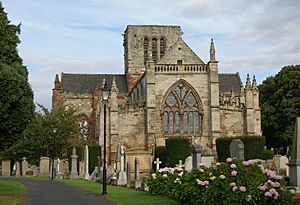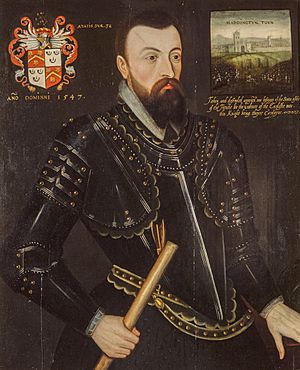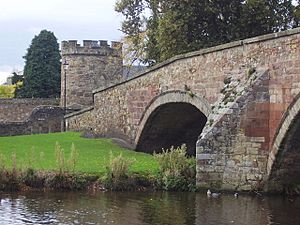Siege of Haddington facts for kids
Quick facts for kids Sieges of Haddington |
|||||||
|---|---|---|---|---|---|---|---|
| Part of Anglo-Scottish Wars Rough Wooing |
|||||||
 The restored Church of St. Mary the Virgin, heavily damaged during the sieges |
|||||||
|
|||||||
| Belligerents | |||||||
| Commanders and leaders | |||||||
| Earl of Arran Lord Methven André de Montalembert Henri Cleutin |
Earl of Shrewsbury Baron Grey of Wilton Sir James Wilford Sir Thomas Palmer Thomas Gower |
||||||
| Strength | |||||||
| 5000–6000 | Up to 15,000 | ||||||
| Casualties and losses | |||||||
| Unknown | Unknown | ||||||
The sieges of Haddington were a series of attacks on the town of Haddington in Scotland. These sieges were a big part of the War of the Rough Wooing, which was one of the last wars between England and Scotland.
After Scotland's Regent Arran lost the battle of Pinkie Cleugh in 1547, English forces took over Haddington. Their plan was to build a group of English forts across Scotland. The English built strong defenses and managed to hold off attacks from Scottish and French soldiers in July 1548. Even though the main attack failed, the English left Haddington on September 19, 1549. They left because of constant Scottish raids, sickness, and changes in the political situation.
Contents
Why Haddington Was Important
The English wanted to control Haddington because it was a good place to build a fort. They hoped that defending Haddington would use up a lot of Scotland's and France's money and soldiers.
Building the Fortifications
The English commander, Grey of Wilton, took control of Haddington and nearby villages by February 1548. He brought in soldiers, including 200 Albanian fighters.
Grey and Thomas Palmer started to build strong defenses around the town in April 1548. They wanted to protect all the important buildings inside Haddington. They cleared the land and dug trenches to defend against enemies.
Soldiers and special workers called 'pioneers' built the defenses. They brought wood from nearby forests. Even though the town was overlooked by hills and far from the sea, the finished fort was very impressive.
The fort had four strong corner towers called bastions. These were named after their commanders: Bowes, Wyndham, Taylor, and Tiberio. Francisco Tiberio led a group of Italian soldiers. The town's tall stone building, the tollbooth, was filled with earth to make a gun platform.
A Spanish Force Tries to Join
In June 1548, Grey of Wilton tried to trick the French. He sent 100 Spanish soldiers, led by Pedro de Negro, to join the Haddington fort. But they ran into the enemy and had to escape to Berwick.
The Attacks on Haddington

Sir James Wilford commanded the English soldiers defending Haddington. The Scottish army brought large cannons from other battles to attack the town. These cannons were brought by ship to Aberlady, a nearby port.
On July 5, 1548, Lord Methven, who was in charge of the Scottish cannons, told Mary of Guise that his guns were doing a lot of damage. He said they had destroyed the Tollbooth inside the town. English records show that James Wilsford worked every night to fix the damage caused by the cannons during the day.
July 1548: The Main Siege Begins
French and Scottish troops started a serious attack on Haddington in July 1548. They prepared ladders to storm the town. Meanwhile, the English army outside Haddington planned how to get supplies to the defenders.
On July 8, Spanish and English horsemen, led by Pedro de Negro, rode through the French lines to bring gunpowder to the fort. They even killed their own horses outside the town gates to avoid riding back through the enemy.
Mary of Guise came to watch the siege on July 9. A cannon shot landed close to her, hurting some of her companions, and she fainted. Around the same time, Mary, Queen of Scots left Scotland from Dumbarton Castle to go to France.
The English inside Haddington were digging tunnels to counter the French and Scottish tunnels. On July 16, a Scottish force tried to storm the town but was pushed back by cannon fire. After this, the French officer d'Essé ordered the heavy guns to be moved away.
August 1548: The Siege is Lifted
In August 1548, the Scots and French set up a base at Clerkington, protected by wide ditches. A large English army arrived on August 23. Because of this, the French and Scots gave up their siege of Haddington and went back to Edinburgh and Leith.
October and November 1548: Night Raids and Sickness
In October 1548, French soldiers in Edinburgh got into a fight with local Scots. To improve their image, the French tried a surprise night attack on Haddington. But the English guards shouted an alarm, and the attack was stopped.
By November 1548, the English soldiers inside Haddington were suffering badly from the plague. Sir James Wilford wrote that many soldiers were sick or had died. He said that fewer than 1,000 soldiers were healthy enough to defend the walls.
The English Leave Haddington
The English decided to leave Haddington because they were running out of supplies. Many of their soldiers had died from disease or during the Scottish night raids. Also, more French soldiers had arrived to help the Scots.
The English soldiers, along with their German and Spanish allies, left Haddington on September 19, 1549. They marched overland to Berwick upon Tweed. Mary of Guise and the Scots were very happy about this victory.
Stories from the Siege
The English writer Ulpian Fulwell wrote down stories he heard from soldiers who fought at Haddington. He described a siege at Yester Castle, where Scottish and Spanish soldiers surrendered. Everyone was pardoned except one soldier who had insulted the English leaders.
This soldier, either Newton or Hamilton, had to fight a duel in Haddington's market square. Newton won the duel, killing Hamilton, and was set free. Fulwell also mentioned that the cannon that almost hit Mary of Guise was called "roaring meg."
Images for kids







